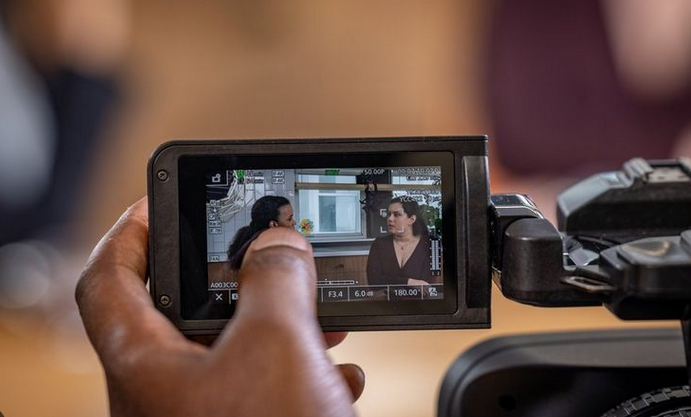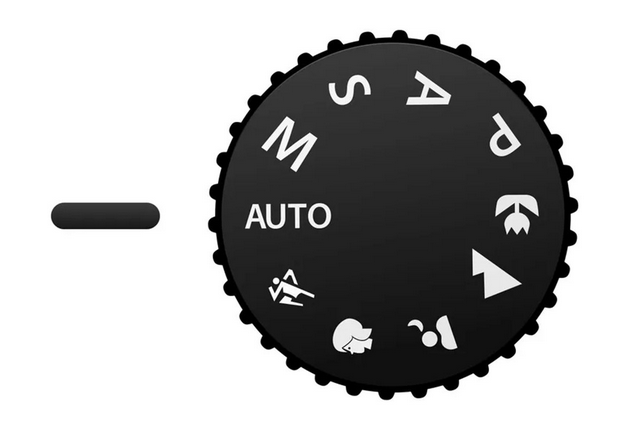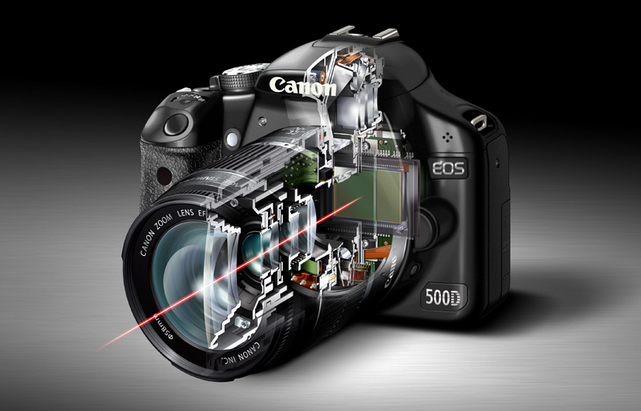Table of Contents
What is DSLR camera?
The acronym DSLR camera represents “Digital Single-Lens Reflex.” This kind of digital camera lets light enter the lens and reach the optical viewfinder by means of a mirror system. The mirror flips up when the shutter button is depressed, letting light onto the image sensor so that a picture can be taken. DSLRs are well-liked by pros and amateurs alike for their capacity to produce precise, artistically controlled, high-quality shots. These cameras are renowned for their adaptability, interchangeable lens compatibility, and manual control options.
Why selecting the appropriate camera is essential in photography?
For a number of reasons, including the fact that it has a big impact on both the quality of their photos and their overall photography experience, selecting the correct camera is essential for those who enjoy taking pictures. The following main ideas emphasize how crucial it is to choose the appropriate camera:
1. Image Quality

- Different cameras create images with different quality levels due to differences in their sensor sizes, resolutions, and technology.
- Higher resolution, a wider dynamic range, and enhanced low-light performance can all be achieved with the correct camera, producing images that are crisper and more detailed.
2. Flexibility:

- Enthusiasts frequently experiment with several genres of photography, including macro, action, portrait, and landscape.
- Selecting a flexible camera that has an array of functions, adjustable settings, and interchangeable lenses enables photographers to adjust to various scenarios and proficiently record a wide variety of topics.
3. Control and Creativity:

- People can exert more creative control over their images by using a camera equipped with manual controls for shutter speed, aperture, and ISO.
- Setting adjustments make it possible to try out various methods and produce particular artistic effects.
4. Performance in Different Conditions

- The ideal camera should work well under various lighting circumstances, from bright sunlight to low-light environments.
- The camera’s capacity to manage various shooting scenarios is influenced by factors including ISO performance, autofocus speed, and image stabilization.
5. Usability:

- Enjoyable photography can be enhanced by intuitive controls and user-friendly interfaces.
- Enthusiasts may value cameras with easily navigable menu systems and ergonomic designs, which facilitate setting changes and smooth moment capture.
6. Size and Portability:

- Aficionados may take the camera’s size and weight into consideration, according on their tastes and planned use.
- For vacation or street photography, some photographers like smaller, more portable cameras; for professional work, others would select larger, more feature-rich equipment.
7. Upgradability and System Compatibility:

- Since photography is frequently a lifelong passion, aficionados might prefer a camera system that is adaptable to future changes.
- Selecting a camera from a manufacturer that offers an extensive selection of lenses and accessories offers you the ability to expand and adjust to your changing demands.
8. Considering the Budget:

- The ideal camera fits the photographer’s budget by finding an equilibrium between features and price.
- Recognizing personal preferences helps enthusiasts ensure they have the skills needed for their favorite style of photography without going overboard on features they might not utilize.
To summarise, selecting the appropriate camera is crucial for photography fans as it should improve image quality, grant creative freedom, accommodate different shooting situations, be user-friendly, and accommodate personal preferences and financial limitations. With the correct camera, fans may express their creativity and capture events with accuracy and satisfaction like never before.
The evolution of technology over time.
Over time, photography has seen a tremendous technological evolution that has changed how photographs are taken, processed, and disseminated. An outline of significant technical advancements in photography is shown below:
Film to Digital Transition:
1. During the middle of the 20th century, film rolls were the primary method of picture capture in photography.
2. With the advent of digital sensors in the latter half of the 20th century, the industry underwent a complete transformation that made instantaneous image preview, memory card storage, and post-processing simpler.
Digital image sensors:
1. Advances in sensor technology have produced sensors with greater dynamic range, resolution, and low-light performance.
2. The introduction of different sensor types, such as CCD and CMOS, has affected the capabilities and quality of digital cameras.
Systems with Autofocus:
1. Manual focusing was the norm for early cameras, but autofocus technologies have improved throughout time to become quicker, more precise, and able to follow moving objects.
2. Improved focusing capability is a result of advanced autofocus technologies including phase- and contrast-detection.
Picture Stabilization:
1. Sharper images are possible because to the development of optical and sensor-based image stabilization technologies, which are especially useful when using telephoto lenses or in low light.
Sophisticated metering schemes:
1. In order to precisely measure light and establish the ideal exposure settings, metering technologies have developed over time.
2. Advanced metering modes that improve exposure control include matrix, evaluative, and spot metering.
Live View and Electronic Viewfinders (EVFs):
1. Through the viewfinder, EVFs offer a digital preview that simulates exposure in real time and allows for focus peaking.
2. Photographers can create photos using LCD panels' live view feature instead of utilizing the optical viewfinder.
Burst Modes and Fast Shooting:
1. These days, cameras have burst and high-speed shooting settings that allow users to take a quick succession of pictures quickly.
2. Particularly helpful applications of this technology include action photography, sports, and wildlife.
Features of 4K Cinematography and Video:
1. Advanced video features including 4K recording, high frame rates, and professional video settings are available on a lot of contemporary cameras.
2. As a result, still cameras are being used more often in film making and videography.
Wireless and Network Features:
1. Wi-Fi, Bluetooth, and NFC integration enables smooth communication between cameras and other devices.
2. Remote shooting, picture transfer, and control through mobile applications are made possible by wireless capabilities.
Artificial Intelligence and Intelligent Features:
1. Many cameras now come equipped with smart functions as standard, such as face identification, subject tracking, and scene recognition.
2. The application of artificial intelligence to improve camera performance, including image processing and focussing, is growing.
Without a mirror Cameras:
1. A significant change has been brought about by the popularity of mirrorless cameras, which have small bodies, electronic viewfinders, and quick autofocus.
2. Mirrorless systems are becoming more and more popular because to their portability and advancements in technology.Together, these technical developments support the ongoing enhancement of photography gear, giving photographers access to instruments that enhance their creative potential and efficiency when documenting and disseminating visual narratives.
Key Components of a DSLR Camera
Of course! Several essential parts of a DSLR (Digital Single-Lens Reflex) camera combine to produce high-quality photos. Photographers who wish to optimize their creative control and photographic ability must comprehend these elements. The main parts of a DSLR camera are as follows:
Lens

The lens plays a crucial role in directing light onto the image sensor of the camera.
Since most DSLRs come with interchangeable lenses, photographers can select lenses (wide-angle, telephoto, macro, etc.) that best suit their needs.Image Sensor

The electronic part that detects light and transforms it into digital data is called an image sensor.
Full-frame and APS-C are the two primary sensor types found in DSLRs; each has an impact on the depth of field and field of vision.Mirror, as well as Mirror Box:

In order for the photographer to construct the shot, light arriving through the lens is reflected up into the optical viewfinder by the mirror.
The mirror flips up when the shutter button is depressed, allowing light to enter the image sensor and be exposed.Viewfinder

Using a pentaprism or pentamirror system, photographers can use the optical viewfinder to compose and frame their photographs.
Electronic viewfinders (EVFs) on certain contemporary DSLRs further offer a digital preview.Shutter

The shutter regulates how long light is allowed to reach the image sensor.
It has two curtains that open and close to control the shutter speed, or exposure duration, of the picture.The shutter button

Pressing the shutter button causes the shutter mechanism to open, taking the picture.
Light metering and focusing are engaged by partially pressing the button.Aperture

The aperture is a lens aperture that may be adjusted to influence how much light enters the camera.
It impacts exposure and depth of field and is expressed in f-stops.Lens Mount

With DSLRs, you may manually adjust the aperture or use it in conjunction with other exposure settings using controls that are either a dial on the camera body or a ring on the lens.Lens Attachment

The interface that joins the interchangeable lens to the camera body is called the lens mount.
Specific lens mounts are available for many camera types and brands.Mode Dial

Quick access to a variety of shooting modes, including manual, aperture priority, shutter priority, and scene modes, is provided by the mode dial.ISO Regulator

The ISO setting controls how sensitive the camera sensor is to light.
DSLR camera owners can manually change the ISO settings to accommodate varying lighting situations.Button for Exposure Compensation

By pressing this button, users can quickly change the exposure settings of DSLR camera to make up for overexposure or underexposure.System of Autofocus

Sharp focus can be achieved with DSLR camera thanks to autofocus devices that automatically modify the lens.
Face detection, multiple focus locations, and tracking capabilities are examples of advanced systems.LCD Display

The camera's LCD screen shows menus, settings, and pictures that have been taken.
For simpler navigation, certain DSLR camera equipped with touchscreen capabilities.Diopter Modification

The diopter adjustment in DSLR camera, which is next to the viewfinder, enables users to alter the focus of the viewfinder to better suit their eyesight.How these settings affect the final image
The shutter speed, aperture, and ISO settings on a DSLR camera are important factors that affect how the final image is exposed and looks. This is how the image is affected by each setting:
- Shutter Speed:
- Defining the duration of time the DSLR camera’s shutter is open, allowing light to reach the picture sensor, is shutter speed.
- Impact on Visual Aid:
Quick shutter speed (e.g., 1/1000 sec): Reduces motion blur and freezes subjects moving quickly.
Slow shutter speeds, such as 1/30 sec or less, are good for capturing motion blur and giving the - Impression of movement.
Creative Impact: The shutter speed affects the photographer’s capacity to freeze motion, produce long-exposure effects, and manage the amount of motion in a scene.
- Opening:
- Definition: The aperture, which regulates the amount of light entering the DSLR camera, is the size of the lens opening.
- Impact on Visual Aid:
- Large Aperture (f/1.4, for example): Lets in more light, results in a shallow depth of field, and blurs the background (bokeh).
- A small aperture (f/16, for example) lowers light levels, deepens the field of focus, and retains more of the image in focus.
- Creative Impact: Depth of field is influenced by aperture, which changes how much of the backdrop and subject are shown.
- ISO:
- Definition: ISO gauges how sensitive the image sensor on a camera is to light.
- Impact on Visual Aid:
- Low ISO (such as ISO 100): Provides pictures with less noise, but more light is needed for the right exposure.
- High ISO (i.e., ISO 1600 or higher): Boosts light sensitivity, enabling low-light photography, but may also add more noise.
- Creative Impact: ISO adjustment plays a critical role in adjusting the trade-off between light sensitivity and image noise, as well as balancing exposure in different lighting conditions.
- Exposure Triangle:
- Definition: The relationship between shutter speed, aperture, and ISO to achieve a balanced exposure is represented by the exposure triangle.
- Effect on Image: To maintain correct exposure, adjusting one setting requires adjusting the others as well.
- Creative Impact: Photographers who grasp the exposure triangle are better able to manipulate the visual elements of their shots.
- Collective Effect:
- Definition: The combined impact describes how adjustments to the shutter speed, aperture, and ISO affect the picture as a whole.
- Effect on Image: The brightness, sharpness, depth of field, and overall aesthetic appeal of the picture are all affected by how these settings are adjusted.
- Creative Impact: By carefully modifying these parameters, photographers can create certain effects, such softening the background, freezing motion, or highlighting a subject.
To sum up, photographers may express their creative vision, adjust to various shooting settings, and control exposure by learning how shutter speed, aperture, and ISO interact. To take interesting and well-exposed photos, you must play around with these settings and learn about their separate and combined impacts.
Popular DSLR Camera Models in 2024
- Nikon D3500.
- Canon EOS 90D
- Nikon D780.
- Nikon D7500.
- Canon EOS 6D

